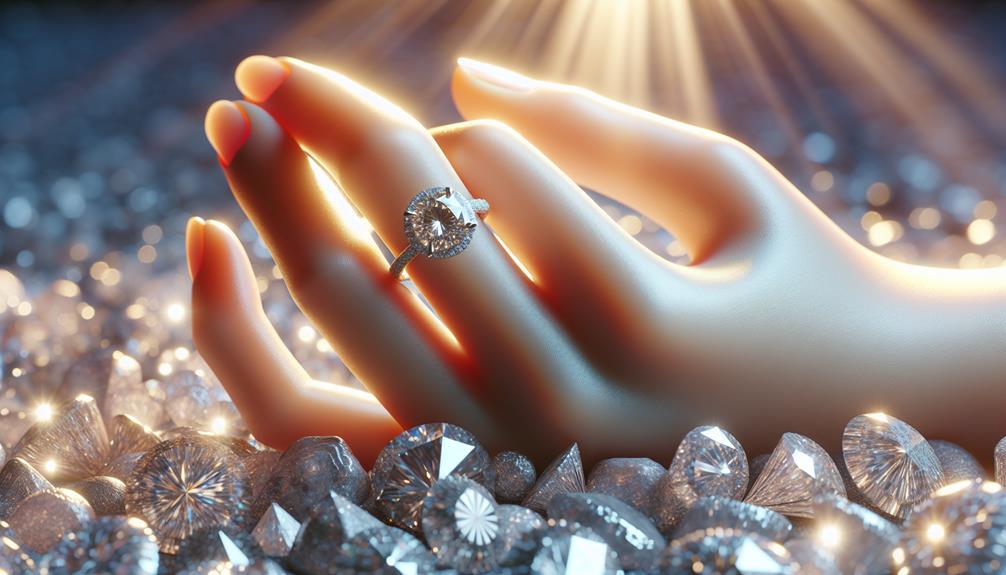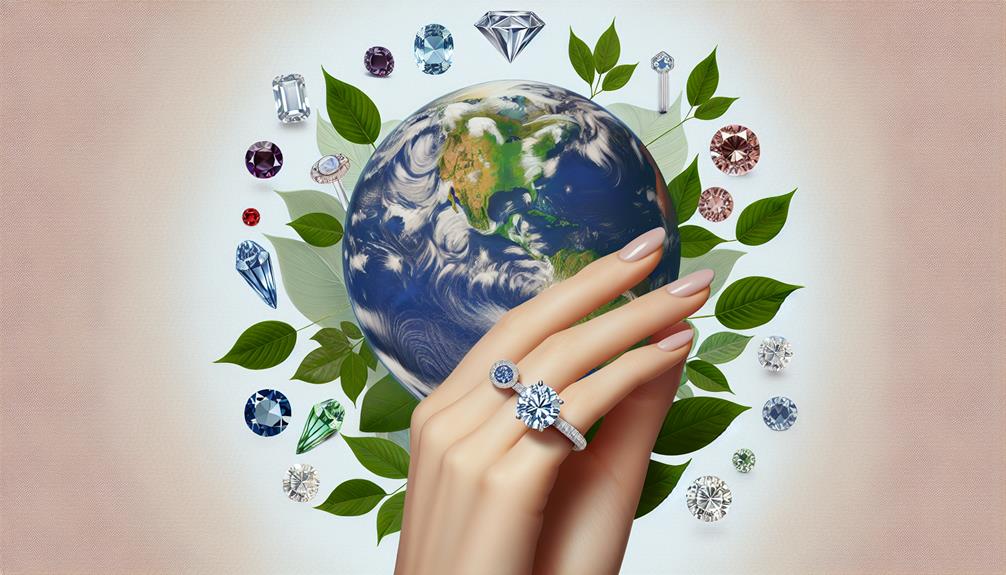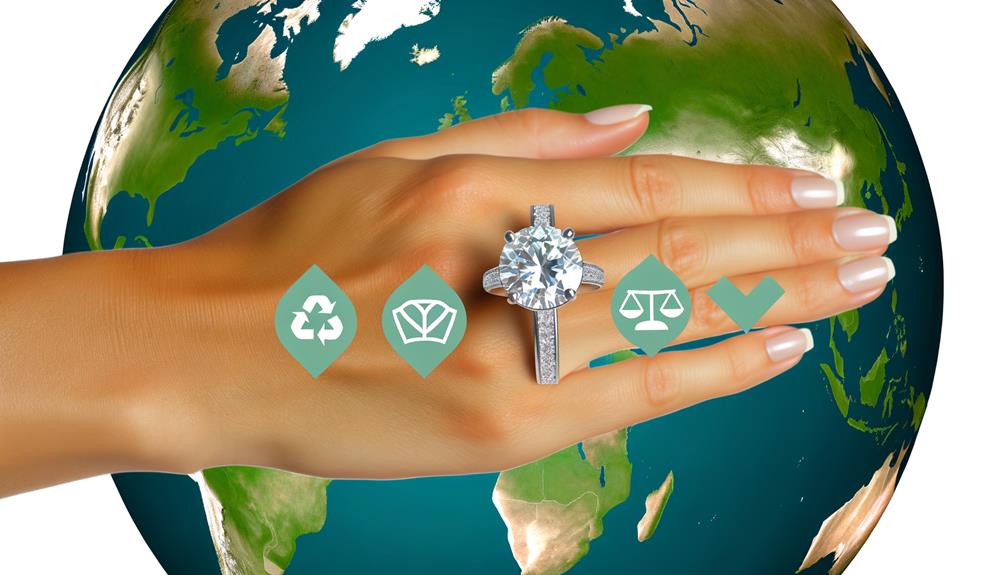Article Contents
In today's market, people love ethically sourced diamond engagement rings. It's not only their sparkle or design. It's the story and honesty behind each stone. Couples want their love symbol to show their values too. Knowing about ethical sourcing is key.
The Kimberley Process shows clear ethics. Lab-grown diamonds offer new choices. Recycled gems bring their own charm. Choosing the right engagement ring is about ethics and taste. This choice says a lot about love, duty, and wanting a better world.
Let's explore these options. We'll see how your choice helps the bigger picture of sustainability and ethics.
Key Takeaways
- Diamonds from Botswana and Canada are ethically sourced. They focus on fair work and environmental protection.
- Lab-created diamonds offer a green, less expensive choice. They match the beauty and quality of mined diamonds.
- The Kimberley Process aims to make sure diamonds don't come from conflict areas. It cuts down on the trade of conflict diamonds.
- Choosing recycled diamonds or metals for engagement rings promotes sustainability and ethical practices in the industry.
Understanding Ethical Diamonds
In today's market, more couples want diamonds that are ethically sourced. They look for diamonds that come from places without conflict and that help local communities and the environment. People now want their jewelry to be beautiful and to come from sources they can feel good about.
At the heart of this movement are ethical mining practices. Diamonds from places like Botswana, Namibia, Australia, and South Africa are popular. Buyers know these diamonds do not fund conflicts. They also know these diamonds help the places where they come from. These areas have rules that protect workers, help local communities, and lessen harm to the environment.
There's also a growing interest in recycled diamonds. These diamonds get a new life in new jewelry. They show a love for sustainability and reducing harm to the planet. Brands such as Canadamark and Kalahari Dream Diamonds lead by example. They make sure their diamonds help the communities they come from. This makes buyers more confident in their choice. Now, people can choose jewelry that matches their values.
The Kimberley Process Explained
The Kimberley Process shines as a key player in the pursuit of ethically sourced diamonds. Launched by the UN in 2003, it aims to stop conflict diamonds from entering the market.
It also works to make the origins of diamonds clear. If you're choosing a diamond with ethics in mind, knowing about this process is crucial.
Origins of Kimberley Process
The Kimberley Process started in 2003. The United Nations led it to fight conflict diamonds. It put strict rules on their trade. The history of this movement shows a big change towards buying diamonds ethically.
- International rules have changed how we trade diamonds.
- The process ensures that 99.8% of diamonds are free from conflict.
- All countries that join must follow the rules. This keeps the trade of ethical diamonds safe.
- Each rough diamond comes with a Kimberley Process certificate. This proves it's from a clean source.
Think of a future where your symbols of love do not come from conflict. Know that your choices help a worldwide effort for freedom and ethical responsibility in the diamond trade.
Impact on Diamond Trade
The Kimberley Process, started by the UN in 2003, reshapes the global diamond trade. It brings strict market rules, cutting down the conflict diamond trade by 99.8%. This change not only impacts the world but also supports ethical sourcing.
Countries now have to follow these rules. The system and the GIA's work on diamond origin reports add transparency and ethics. They make sure diamonds come from places that don't harm their people.
This move towards clear origins isn't just about rules. It's about making every diamond stand for freedom and integrity.
Lab-Grown Diamond Options
In the search for ethically sourced diamond engagement rings, lab-grown diamonds stand out. They match the beauty and strength of mined diamonds.
Yet, they cost less and harm the environment less. For couples who value sustainability and elegance, lab-grown diamonds are a smart, affordable option.
Benefits of Lab-Grown
Choosing lab-grown diamonds blends sustainability and ethical luxury, appealing to the refined tastes of today's buyers. These stones provide guilt-free enjoyment and a step towards a more thoughtful choice. They align with the desires of those seeking uncompromised freedom.
- Environmental benefits: Greatly reduces damage to land and lowers water use.
- Quality comparison: Matches the beauty and traits of mined diamonds.
- Pricing advantages: Makes luxury more affordable.
- Sustainable choice: Promotes ethical methods, steering clear of traditional mining's issues.
Lab-grown diamonds unite timeless charm with modern ethics, making them a perfect symbol of love for the progressive person.
Comparing Cost Differences
When comparing the cost of engagement rings, choosing lab-grown diamonds saves money. They offer luxury and are kinder to the planet, costing much less than traditional mined diamonds.
| Factor | Lab-Grown Diamonds | Traditional Mined Diamonds |
|---|---|---|
| Starting Price/Carat | $1,000 | $3,000-$5,000 |
| Cost Savings | 20-40% less | – |
| Sustainability Benefits | High | Lower |
| Chemical Composition | The same | The same |
Picking lab-grown diamonds means not giving up quality or ethics. The big savings and the good they do for our planet make them a smart pick for those wanting a thoughtful, ethical, and unique choice for their engagement ring.
Canadian Diamond Sources
Sourcing diamonds from Canada's Northwest Territories ensures ethical mining and transparent, conflict-free gems. These align with modern values. Canadian diamonds are more than stones. They symbolize ethical care and mindful shopping. They stand for freedom and oppose exploitation found in conflict-zone diamond mining.
Canadian diamond benefits and support for Indigenous communities make these gems a top pick. People choose them for engagement rings that share a love story. Not just with a partner, but with the world.
- Traceability and Transparency: You can trace every Canadian diamond back to its mine. This guarantees a clear, guilt-free journey from the earth to your finger.
- Conflict-Free Assurance: Following the Canadian Diamond Code of Conduct, these gems stand for peace and ethics.
- Environmental Stewardship: Canadian mines lead in responsible diamond extraction, caring for the environment.
- Supporting Indigenous Communities: Picking a Canadian diamond means helping local Indigenous people thrive.
In a world that values authenticity and ethical integrity, Canadian diamonds are a symbol of thoughtful luxury.
Recycled Diamond Choices

In their search for sustainable luxury, many couples choose recycled diamonds for their engagement rings. This choice is part of a larger trend toward eco-friendly jewelry that maintains high quality and design. Recycled diamonds come from existing pieces and match the brilliance and beauty of new diamonds. By picking these gems, couples show their commitment to each other and the planet.
Recycled diamonds are appealing not only because they are ethical but also because they are unique. Each recycled diamond tells a story, adding personal history and emotional value that new diamonds lack. This feature attracts those who want their jewelry to reflect their unique story and relationship.
Moreover, choosing recycled diamonds can be a smart financial move. These diamonds are often more affordable than new ones, without compromising on beauty. This benefit, along with a shift towards personalized, eco-friendly designs, makes recycled diamonds an attractive option for modern couples who value both love and environmental responsibility.
Fairtrade and Recycled Metals
Fairtrade and recycled metals are leading the way in ethical engagement ring production. They aim for both environmental sustainability and social responsibility. Using these materials means your love symbol has a small ecological footprint. It also supports artisanal miners' livelihoods in a meaningful way.
- Fairtrade Benefits and Sustainability: When you choose Fairtrade metals, you support mining practices that care for miners and their communities. This helps with social fairness and protects the environment.
- Recycled Materials, Eco-Friendly Choices: Choosing recycled metals cuts the need for new mining. This lowers your engagement ring's impact on the environment. It shows your commitment to the Earth.
- Diverse Options: Fairtrade gold comes in many looks, from yellow gold's warmth to white gold's cool elegance. You can personalize your ethical engagement ring.
- Supporting Local Economies: Recycled or Fairtrade metal rings do more than save the planet. They also help the economies of mining areas.
Picking an engagement ring with Fairtrade and recycled metals is a modern, concrete, and personal way to show you care about sustainability and social responsibility.
Ethical Gemstone Alternatives

Lab-created diamonds and recycled gems stand out as innovative choices for couples who want ethical and eye-catching engagement rings. These sustainable gemstones match the beauty of traditional diamonds but do it in a way that protects the environment and supports fair labor practices. Thanks to tech advances, lab-grown diamonds look just as stunning as those dug from the earth, minus the environmental harm of mining.
Recycled diamonds breathe new life into existing stones. This method cuts down on the need for new mining and boosts recycling in the jewelry world. For those who value uniqueness and ethical sources, gemstone shows and independent jewelers are key. They offer ethically sourced gems with clear certifications, letting buyers know where their stones come from.
When it's hard to find out where a gemstone came from, lab-made alternatives are a good choice. They promise ethical and eco-friendly sourcing. Choosing these alternatives shows a couple's dedication to caring for the planet and supporting ethical practices.
Choosing Your Ethical Ring
Exploring ethical and eco-friendly gems is vital. The next step for couples is choosing their ethical engagement ring wisely. A ring that reflects your values shows your commitment to each other and the planet. Focus on custom designs and sustainable gems to make your choice:
- Look into Canadian diamonds that comply with the CDCC, recycled diamonds, or diamonds made in labs. These options offer guilt-free shine without losing brilliance.
- Pick a setting from recycled metals, like reused gold or platinum. This choice ensures your ring is beautiful and has a small environmental footprint.
- Ask for transparency and commitment to sustainability from sellers. Make sure they provide rings from ethical sources and support environmental efforts.
- Think about designing a custom ring. This allows you to add personal touches while using sustainable gems and recycled materials.
This method supports sustainability and lets you create a ring that truly reflects your unique relationship and ethical beliefs.
Frequently Asked Questions
Are Ethically Sourced Diamonds Really Ethical?
Ethically sourced diamonds aim for ethical practices through valid certifications and minimal mining impacts. Yet, their true ethics rely on transparent sourcing and strict certification adherence.
Are Tiffany and Co Diamonds Ethically Sourced?
Tiffany and Co commits to ethically sourced diamonds. They make their sourcing policies clear. As a leader, they ensure each diamond is mined responsibly. This appeals to consumers who value ethics and freedom.
How Do I Know if My Diamond Is Ethical?
To ensure a diamond is ethical, look for its certification and choose retailers who are transparent. These steps confirm the diamond's ethical origins, giving peace of mind to buyers who value ethical consumption.
What Is the Difference Between Conflict Free and Ethically Sourced Diamonds?
Conflict-free diamonds avoid funding wars. Ethically sourced diamonds also ensure responsible mining, care for workers, and protect the environment. They meet high ethical standards. This means a wider commitment to good practices in the supply chain.
Conclusion
To choose an ethical engagement ring means understanding where the diamond comes from, how people make it, and how its purchase affects people and the planet. Choosing lab-grown diamonds, Canadian diamonds, recycled materials, and Fairtrade metals shows a commitment to sustainability. It also shows care for the environment and human rights.
An ethically sourced engagement ring stands for a love that is deep and personal. But it also shows a thoughtful and responsible choice. It helps create a fairer and more sustainable future.



